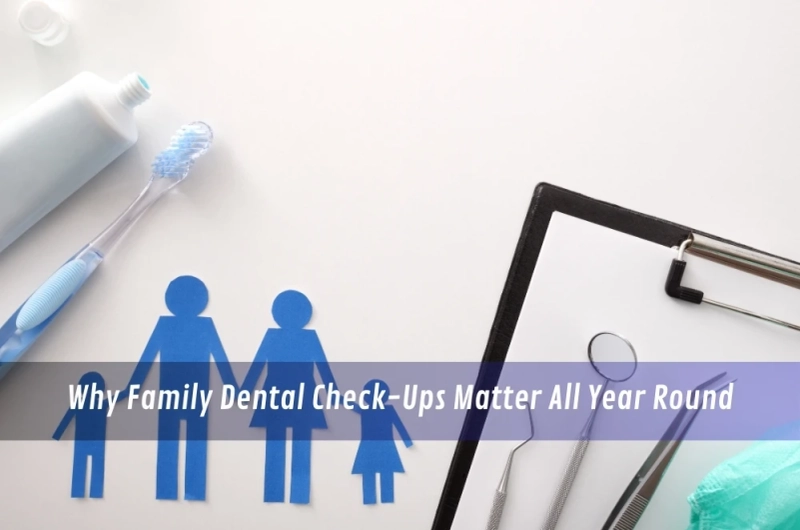I don’t know about you, but in my house, getting everyone to a dental appointment is an event. Not a fun one either. Shoes go missing, someone suddenly remembers a “school project due tomorrow,” and inevitably someone pipes up with, “But my teeth feel fine.” It’s tempting to just throw your hands up and push the appointment back another month.
Thing is, keeping up with general family dental visits isn’t just about fixing problems. It’s about stopping those problems from showing up in the first place — or at least catching them while they’re still small enough to fix without draining your savings.
The trouble with “I feel fine”
Teeth are sneaky. They don’t tap you on the shoulder and say, “Hey, you’ve got a cavity starting.” They just keep doing their thing while the damage builds underneath. By the time you feel something — a twinge when you bite into an apple, sensitivity with your morning tea — it’s usually gone beyond the quick-fix stage.
I learned that the hard way. I once skipped my own check-up for almost a year because I was “too busy”. When I finally went, my dentist pointed out a cavity wedged between two molars. I hadn’t felt a thing. Ten minutes with the drill and some composite, and I was patched up. But she told me if I’d waited a few more months, it could’ve been a crown. That’s the difference a check-up makes.
Everyone’s teeth age differently
That’s the thing about family check-ups — they’re not one-size-fits-all.
- Kids are still learning to brush properly. Baby teeth get cavities too, and sometimes the problem is bad brushing technique, not sugar. Dentists also keep an eye out for crowding or jaw development issues before they become a bigger deal.
- Teens… well, teens are teens. They might be dealing with braces, mouthguards for sports, or just a diet full of soft drinks. All of that leaves a mark.
- Adults tend to have a few battle scars — fillings from younger years, coffee stains, maybe some gum issues if flossing’s not been a priority.
- Older adults face wear and tear, plus dry mouth from medication, which can speed up decay. Sometimes the biggest difference a check-up makes is catching a small crack in a denture before it breaks completely.
The NSW Health page on family oral health advice is worth a look — especially if you’ve got little ones and you’re wondering what’s normal.
The myth of “once a year is enough”
You’ll hear it all the time — “I only go once a year and I’m fine.” That might work for some people. But if you’re prone to cavities, grind your teeth, or have gum issues, once a year can be too long.
Dentists aren’t just looking for obvious problems. They’re checking your gums, jaw, bite, even your tongue. They might spot a hairline crack in a tooth you can’t see. Six months later, that hairline crack could be a weekend emergency.
Think of it like car servicing. You could wait until something breaks down… but it’s usually more expensive and inconvenient that way.
A story from the “wish I’d gone sooner” files
My sister skipped her appointment because her youngest had just started school and she was juggling too much. Eight months later, she bit into a crusty bread roll and felt something give. Pain kicked in within an hour. Turns out the tooth had been cracked for a while and had finally given up. She ended up in the chair for a root canal, three visits, and a bill that could’ve been a short holiday.
We both laugh about it now, but she books her check-ups like clockwork these days.
What a family check-up actually covers
If you’ve ever wondered why the appointment takes 30–45 minutes, even when “nothing’s wrong,” here’s what usually happens:
- Cleaning: Plaque and tartar that brushing and flossing miss.
- Examination: Teeth, gums, tongue, jaw — the lot.
- X-rays: Usually every couple of years to find things hiding out of sight.
- Advice: Tailored to what the dentist sees — could be brushing tweaks, diet changes, or just “keep doing what you’re doing.”
It’s more thorough than most people realise — and it’s often the advice part that saves you down the track.
Diet: The invisible culprit
It’s not always just about sugar. Acidic foods, frequent snacking, and even so-called “healthy” dried fruit can wear enamel over time. Dentists often notice the patterns before you do — the sports-drink habit, the constant grazing, the endless cups of coffee.
I had a friend who couldn’t work out why her teeth were getting sensitive. Turned out she was sipping lemon water all day. Healthy for hydration, terrible for enamel. One chat at her check-up, and she changed to plain water between meals. Problem solved.
Making the whole thing less painful (metaphorically)
I don’t mean the dental work — I mean the hassle of getting everyone there.
- Book back-to-back appointments so you’re in and out in one trip.
- Make it a family habit — same time each year or every six months.
- Pair it with something nice — lunch out, a treat from the bakery, a walk in the park.
- Keep it on a shared calendar so no one “forgets.”
Prevention: The quiet money-saver
You can’t avoid every problem, but you can stack the odds in your favour:
- Brush twice a day with fluoride toothpaste.
- Floss or use interdental brushes daily.
- Limit sugary and acidic foods.
- Wear a mouthguard for sports.
- Drink water regularly.
Why a group appointment can be smarter
There’s something about everyone going at once that makes it less of a big deal. Kids see parents in the chair, parents see kids learning the ropes. Dentists can also spot patterns — maybe everyone has the same enamel weakness, or maybe it’s just a reminder to swap to a softer toothbrush.

Emergencies still happen — but less often
Even with the best habits, you can’t plan for everything. A chipped tooth, sudden pain, or swelling can throw you off. The difference is that if you’re in the habit of regular visits, those emergencies are usually smaller and easier to deal with.
If you want more on handling the urgent stuff, there’s a good oral health education that goes into detail.
Wrapping it up
Look, dental check-ups aren’t exciting. You don’t walk out with a new hairstyle or a set of car keys. But you do walk out knowing you’ve avoided a lot of pain — both physical and financial — down the road.
If you’ve been putting it off, consider this your nudge. The best time to go was six months ago. The second-best time? Now.


